What is Robot Surgery?
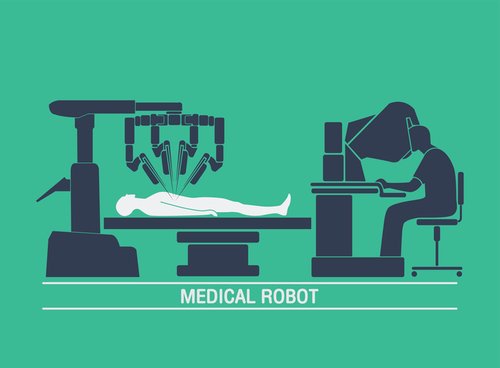
(Source : Getty Images Bank)
Hello, this is @verygoodsurgeon, a surgeon from South Korea.
I'd like to share with you freely interesting topics in surgery. So, the first topic of choice is " What is robotic surgery? "
[Robomedi era!]
As the Fourth Industrial Revolution era approaches, many people are paying keen attention to the upcoming future.
These days, hot issues, such as machine running, artificial intelligence, and block chains, are mainly in the software field. Similarly, the hardware field, which is based on robots, has been making significant strides.
As you know, this is the age when bipedal robots are back tumbling ...
( cf. YouTube video)
So today let's talk about the present and future of medical robots.
Robot surgery? Hmm.. Do robots do surgery by themselves now? If you ask, you are a step ahead.
Now you can see in the medical industry what robotic surgery is like : it's a technique in which a human being can manipulate a robotic arm to perform delicate surgeries.
[Contemporary surgical trends are 'Minimal incisions']
To talk about robot surgery, we must first talk about minimally invasive surgery. Laparotomy, which is a
traditional surgical method, has a wide field of view and allows the operator to use both hands freely, but it has many disadvantages that have delayed wound healing, severe pain, and left large scars as beuty aspect.
In order to overcome these shortcomings, the field of minimally invasive surgery has been pioneered, and laparoscopic surgery is the most representative.
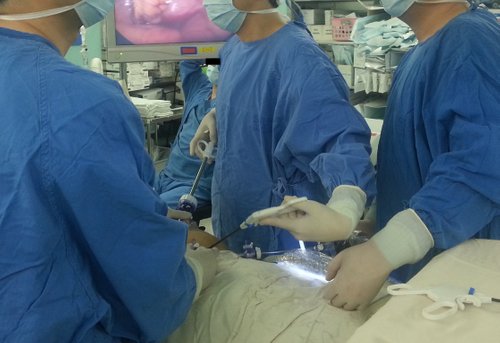
Laparoscopic surgery
Laparoscopic surgery is the way to do surgery with a laparoscopic surgical instrument, such as a 'long bar forcep', while looking through the abdominal cavity with a long rod camera through a hole in the skin .
The development of laparoscopic surgery has helped us compensate for the shortcomings of traditional abdominal surgery, resulting in fewer injuries and faster recovery.
Increasingly, laparoscopic surgery is on the rise, but it does not have only merits. It is uncomfortable, difficult, and has poorly handling on delicate parts.
So next generation is developed, the Robot surgery.
[The Da Vinci Code? No, da Vinci robot surgery!]
Robot surgery currently being performed is as follows.
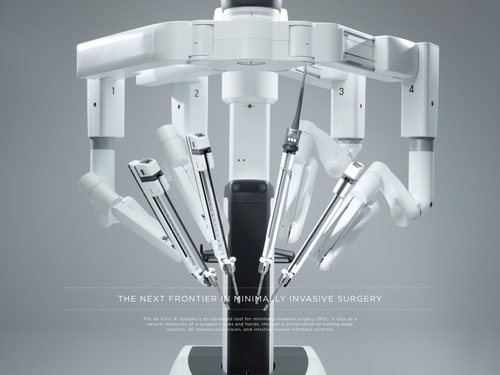
Da Vinci surgical robot
First, the patient's skin is punctured with four small holes to insert the camera and the robot arm, and the operator is seated in front of the machine called Console . When you put your head into this machine, you can see a sparkling vivid screen full of 3D, and manipulate your robot arm intuitively with a joystick-like part wirelessly.
That's how it works.
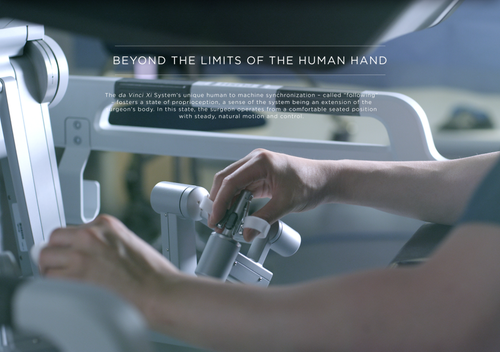
And when you combine them, it looks like the image that I showed you in the beginning.

(Source : Getty Images Bank)
Surgical robots are almost a monopoly system of Da Vinci, an American surgical robot manufacturing company.
DaVinCI surgical robots were first developed in 1999 (the name is from Leonardo da Vinci, who was known as the world's first robot designer), and first introduced in 2016 at Severance Hospital in South Korea.
Health ministry data shows that in 2014, 8840 robotic surgeries were already being performed in South Korea, and they're growing really fast.
[Advantage]
- Excellent accuracy
(Camera can zoom-in about 10 times than naked-eye, and robot arms never shake hands.) - Wide range of motion
(< - More joints than laparoscopic tools, so it moves better.) - Enhanced Operational Agility
(< - It's easier to manipulate because it's much more intuitive, like playing a 3D game) - Clear visual information and improved accessibility
(<- It has a good camera) - Shorter hospitalization, fewer pain, less risk of infection, fewer scars, faster recovery and faster return to normal life
(< - are all the same. Fewer wounds make less sick, recover quicker, and leave the hospital faster.) - Reduce bleeding and reduce the need for blood transfusion
(- boast of being as sophisticated)
Besides
- Teleoperation(Remote controlled surgery) is also possible
It is not the direction that the da Vinci company is currently pursuing, but it was actually Lindbergh surgery. In 2001, a surgeon from New York City in the United States operated cholecystectomy(removing gallbladder) to a patient in Strasbourg, France, using a remote controlled robot.
So some doctors said that robotic surgery is a combination of the advantages which laparoscopic surgery and open surgery have.
So far, thyroid surgery, stomach cancer surgery, gall bladder surgery, pancreas surgery, kidney surgery, gynecosurgery, prostate cancer surgery -- it is widely used and is expected to grow.
Weakness
I think the downside to robotic surgery is only high costs compared with laparoscopic surgery.
Currently in Korea, health insurance can not cover 100 % on these robotic operations, and the cost of the operation is over 10 million won, depending on the hospital. I'm afraid :(
Some private insurances are more likely to cover these, so it can be good choice.
As technology advances and as hospitals compete against each other, I think prices will go down gradually.
[The Future of Medical Robots]
The da Vinci surgical robots have evolved such as lighter arms and wider movements.
There is likely to be a upgrade version coming out that is not yet commercially available, but can be operated on with only one hole. It was like a snake.
You can see it's quite innovative compared to the previous robots, right?
But there seem to be many mountains to cross. Typically the working range and the supporting force are still small. But this will soon be overcome, i think :)
What else is being developed, besides the da Vinci surgical robot?
[Suture robot]
Now Robot can do the suturing themselves.
[Micro-robot]
They put a tiny robot in an syringe, and put it into a blood vessel, these can be used to treat inside of it.
In addition, an remote control capsule endoscope is being developed that can be adjusted arbitrarily.
the capsule endoscopy that is currently in clinical use is a 'passive capsule endoscope' that physician can not manipulate the speed or direction . It is mainly used to look inside the small intestine where the stick endoscope can not enter. Also, It can not be checked in real time. Only after finishing record the video, operator can look at the video and see if patients have a problem with their small intestine. If the camera on the capsule is pointing in the opposite direction of critical location, the lesion may be missed.
But the active capsule in its latest development phase can adjust its speed or direction as desired, and it can even inject some drugs.
[Bacterial robot]
A micrometer-sized bacterial robot developed at Chonnam National University is actually combining bacteria and robots, injecting them into a blood vessel and they can find the cancer cells, and then selectively destroy cancer.
And with so many futuristic medical robots in development, I can't help but exciting.
[At the end of posting]
So let's take a careful look at the surgical robots in my head.
I think the limitation of robotic surgery now is basically 'I can not touch' in a word. No matter how sophisticated or fast you move your high-tech chopsticks to move the beans, it wouldn't be like pulling a handful of beans by hand.
So the ultimate surgical robot that I can imagine is the robotic hand to feel.
Only one small incision is made in the skin and the separated robot fingers are inserted one by one. When all 10 robotic fingers are in the abdominal cavity, they bond together, and when both hands are in the belly and the camera are set, they're ready to operate. Each of these robotic fingers has a tactile sensor, which actually passes over to the hand of the surgeon in the module when the hand grabs the organ.
With a camera 10 times larger than that, you can look closely and feel the touch without shaking your hands, it's almost as if the surgeon was actually burying his face in his or her stomach and doing it with his hands.
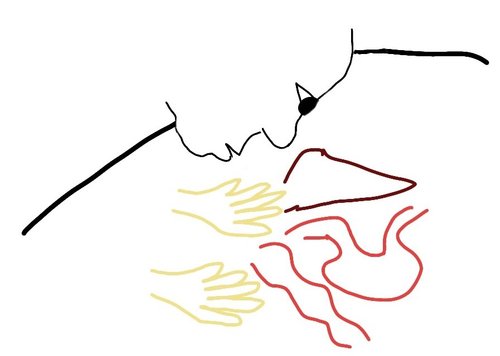
Sombody wants to buy this idea? lol :)
Next time, I will come to a more interesting medical topics.
Happy new year!!

핫핫 한글로도 읽고 싶습니다ㅎㅎㅎ 외과선생님 새해 복 많이 받으세요!
감사합니다. 이전 포스팅에 한글로 된 원문이 있으니
관심있으시면 한번 읽어주세요^^
One day it will be possible to operate a patient in England while the doctor is in South Korea, spectacular!
Upvoted and resteemed. Do you want to know why? Visit @pf-coin.
thanx for visiting me :)
happy new year!
와 능동 캡슐 내시경이라니, 이제는 정말 초소형으로 안에 다 들어가 있도록 개발했군요... !!! 의료 로봇이 가장 발달한 나라는 어디인가요???
일본 아닐까요??
저도 그것까진..하지만 자본이 있는 곳에서 기술이 발전하는지라 아무래도 미국이 세계 의료시장을 선도하고 있긴 합니다.